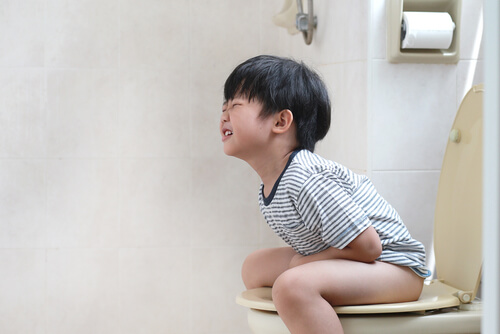How to Identify Appendicitis in Children

When it comes to identifying appendicitis in children, the classic symptoms suffered by adults aren’t reliable. Loss of appetite, nausea and vomiting aren’t exclusive indicators of this condition.
The diagnosis of appendicitis in children isn’t simple. The symptoms of appendicitis in children are similar to other diseases, such as gastroenteritis, food poisoning or respiratory disorders.
Only 33% of pediatric cases present the symptoms described. Therefore, it’s necessary to sharpen your senses before certain warning symptoms show up.
What Is Appendicitis?
Appendicitis is inflammation of the appendix and usually occurs because it is blocked. It can be caused by hardened stools, by infection or due to inflammation of the lymph nodes located in the intestine.
It’s a serious condition if the appendix ruptures. When this happens, bacteria are released into the abdominal cavity. This can cause a severe infection.

For physiological reasons, the spread of infection after rupture is imminent. Because of this, peritonitis is considered a serious illness, which can be fatal in some cases.
Identifying Appendicitis in Children
Actually, appendicitis isn’t very common in children. This makes it the main reason to confuse its symptoms with those of other diseases. It will be necessary, then, to be attentive mainly to stomachaches, which are one of the clearest signs.
Appendicitis pain begins in the navel area and, after a few hours, it extends to the lower and right part of the abdomen. The first thing would be to determine the severity of the pain. If the child feels pain, but continues playing, eating and laughing, it’s probably not that serious.
If the child complains of severe pain that limits his normal functions, it is necessary to go to the emergency room immediately. In some cases, children with appendicitis complain of a discomfort in the right leg, due to the pain reflex.
“Appendicitis is inflammation of the appendix and usually occurs because it is blocked. It can be caused by hardened stools, by infection or due to inflammation of the lymph nodes located in the intestine.”
Warning Signs
Beyond stomach pain, it is necessary to pay attention to other signs. These symptoms are:
- Stomach pain: Pain in their stomach is accompanied by vomiting blood. Also, the stool may contain blood traits.
- Vomiting green fluid: This fluid could be bile, a sign of torsion or blockage in their stomach or intestines. In these cases, you’re facing a real health emergency.
- Distended abdomen: It can be caused by appendicitis, but also by other types of diseases.
- Pain when you push on their abdomen: Especially if it’s pressed and then suddenly released. Usually, this pain means that the peritoneal lining, the membrane that lines the abdominal cavity, is inflamed.
- Being in the fetal position: This occurs when the child complains of abdominal pain and lies down sideways with their legs toward their abdomen.
- Difficulty keeping good posture when walking: The child complains of abdominal pain and walks bent over.

Appendicitis Treatment
Treating appendicitis in children will require surgically removing their appendix. If the child’s appendix didn’t burst, you’ll be given antibiotics to decrease the infection and remove it. When the appendix has ruptured, in addition to taking it out, you’ll need to pay close attention to clear the peritoneal cavity.
Once the appendix bacteria are gone, a larger surgery is required as part of the treatment. The goal is to ensure that the bacteria present don’t travel to other parts of the abdomen and cause a serious infection.
Children whose appendix has ruptured should stay longer in the hospital. It’s important to start receiving intravenous antibiotics because the risk of infection is very high.
When it comes to identifying appendicitis in children, the classic symptoms suffered by adults aren’t reliable. Loss of appetite, nausea and vomiting aren’t exclusive indicators of this condition.
The diagnosis of appendicitis in children isn’t simple. The symptoms of appendicitis in children are similar to other diseases, such as gastroenteritis, food poisoning or respiratory disorders.
Only 33% of pediatric cases present the symptoms described. Therefore, it’s necessary to sharpen your senses before certain warning symptoms show up.
What Is Appendicitis?
Appendicitis is inflammation of the appendix and usually occurs because it is blocked. It can be caused by hardened stools, by infection or due to inflammation of the lymph nodes located in the intestine.
It’s a serious condition if the appendix ruptures. When this happens, bacteria are released into the abdominal cavity. This can cause a severe infection.

For physiological reasons, the spread of infection after rupture is imminent. Because of this, peritonitis is considered a serious illness, which can be fatal in some cases.
Identifying Appendicitis in Children
Actually, appendicitis isn’t very common in children. This makes it the main reason to confuse its symptoms with those of other diseases. It will be necessary, then, to be attentive mainly to stomachaches, which are one of the clearest signs.
Appendicitis pain begins in the navel area and, after a few hours, it extends to the lower and right part of the abdomen. The first thing would be to determine the severity of the pain. If the child feels pain, but continues playing, eating and laughing, it’s probably not that serious.
If the child complains of severe pain that limits his normal functions, it is necessary to go to the emergency room immediately. In some cases, children with appendicitis complain of a discomfort in the right leg, due to the pain reflex.
“Appendicitis is inflammation of the appendix and usually occurs because it is blocked. It can be caused by hardened stools, by infection or due to inflammation of the lymph nodes located in the intestine.”
Warning Signs
Beyond stomach pain, it is necessary to pay attention to other signs. These symptoms are:
- Stomach pain: Pain in their stomach is accompanied by vomiting blood. Also, the stool may contain blood traits.
- Vomiting green fluid: This fluid could be bile, a sign of torsion or blockage in their stomach or intestines. In these cases, you’re facing a real health emergency.
- Distended abdomen: It can be caused by appendicitis, but also by other types of diseases.
- Pain when you push on their abdomen: Especially if it’s pressed and then suddenly released. Usually, this pain means that the peritoneal lining, the membrane that lines the abdominal cavity, is inflamed.
- Being in the fetal position: This occurs when the child complains of abdominal pain and lies down sideways with their legs toward their abdomen.
- Difficulty keeping good posture when walking: The child complains of abdominal pain and walks bent over.

Appendicitis Treatment
Treating appendicitis in children will require surgically removing their appendix. If the child’s appendix didn’t burst, you’ll be given antibiotics to decrease the infection and remove it. When the appendix has ruptured, in addition to taking it out, you’ll need to pay close attention to clear the peritoneal cavity.
Once the appendix bacteria are gone, a larger surgery is required as part of the treatment. The goal is to ensure that the bacteria present don’t travel to other parts of the abdomen and cause a serious infection.
Children whose appendix has ruptured should stay longer in the hospital. It’s important to start receiving intravenous antibiotics because the risk of infection is very high.
This text is provided for informational purposes only and does not replace consultation with a professional. If in doubt, consult your specialist.








